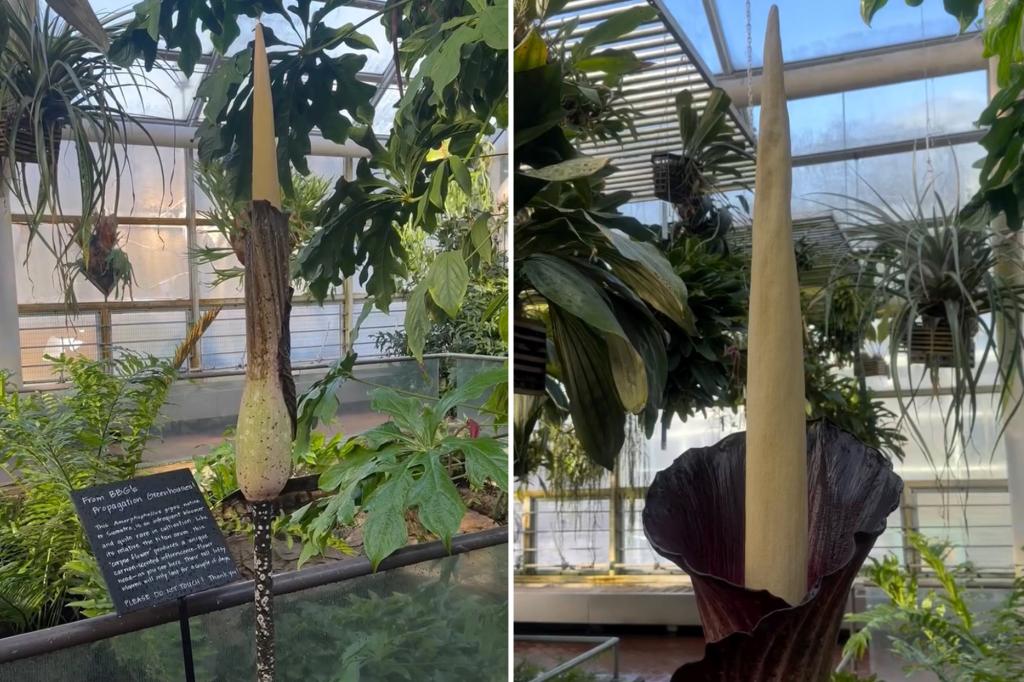The Brooklyn Botanic Garden (BBG) recently witnessed a historical event: the blooming of an Amorphophallus gigas, commonly known as the corpse flower, for the first time in New York City’s history. Nicknamed “Smelliot” by the garden staff, this rare Sumatran plant unfolded its striking petals, releasing its characteristic pungent odor of decaying flesh, much to the intrigue and occasional disgust of visitors. The bloom, which began on a Friday morning, drew a crowd eager to witness this infrequent botanical spectacle. While the adults generally embraced the unique stench, children were observed reacting with predictable nose-wrinkling and aversion.
This bloom marks a significant achievement for the BBG, distinguishing it as one of only ten botanical gardens worldwide to cultivate the Amorphophallus gigas. While the garden has previously hosted the blooming of its close relative, the Amorphophallus titanium, in 2006 (the first in seven decades) and the New York Botanical Garden also witnessed a titanium bloom in 2023, the gigas variety is considerably rarer in cultivation, adding to the significance of this event. Planted seven years prior by Patrick Austin, a plant propagator and nursery gardener at BBG, Smelliot’s blooming was a culmination of years of patient care and anticipation.
The Amorphophallus gigas is renowned not only for its size and unusual appearance but also for its infrequent blooming cycle. These plants can take anywhere from several years to a decade to flower, making each bloom a highly anticipated event. BBG staff first suspected the imminent bloom when Smelliot’s rapid vertical growth began to slow, initially attributing it to a cold spell. However, the near cessation of growth and the emergence of a subtle yet unmistakable foul odor signaled the impending botanical marvel. The intensification of the stench upon the flower’s opening is a deliberate evolutionary strategy, attracting pollinators like flies and beetles that are typically drawn to the smell of decaying matter.
The corpse flower’s putrid aroma is integral to its reproductive strategy, mimicking the scent of carrion to attract its preferred pollinators: flies and beetles that feed on dead animals. This specialized pollination strategy ensures the continuation of the species in its native habitat. The flower’s unique stench is most potent immediately upon opening, maximizing its appeal to these specific insects. This evolutionary adaptation highlights the intricate relationship between plants and their pollinators, even in the case of such unusual and seemingly unpleasant aromas.
The rarity of the Amorphophallus gigas, coupled with its infrequent blooming, makes this event a truly exceptional experience. The BBG witnessed a surge in visitors in the week leading up to the bloom, with everyone eager to witness this remarkable plant. The fleeting nature of the bloom, lasting only a few days before the flower folds back up and sheds its petals, further adds to the allure and urgency of the experience. The short-lived display emphasizes the unique and rare opportunity presented by Smelliot’s flowering.
This remarkable blooming of the Amorphophallus gigas at the Brooklyn Botanic Garden represents more than just a singular botanical event. It underscores the importance of botanical gardens in conserving and showcasing rare and unusual plant species, providing opportunities for the public to learn about and appreciate the diversity of the plant kingdom. The event also highlights the intricate and often surprising adaptations plants have evolved for survival and reproduction, such as the corpse flower’s ingenious strategy of attracting pollinators with its pungent odor. The fleeting nature of the bloom further emphasizes the preciousness of such occurrences and the importance of preserving these remarkable plants for future generations.

